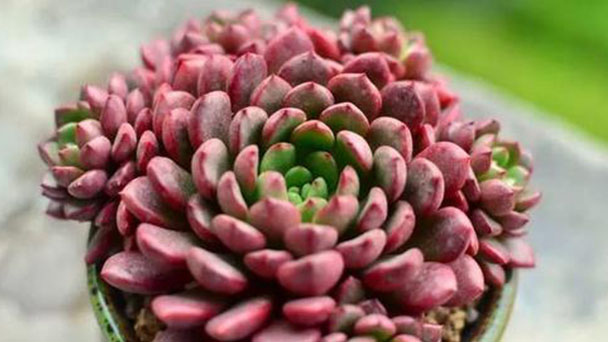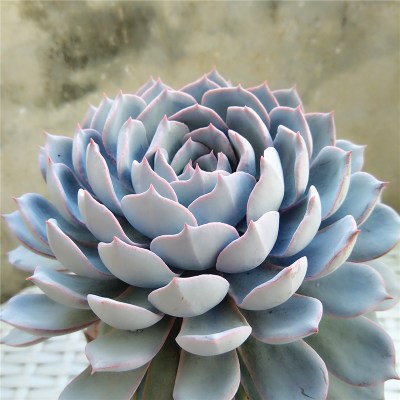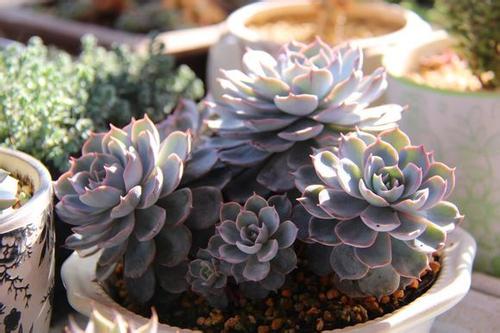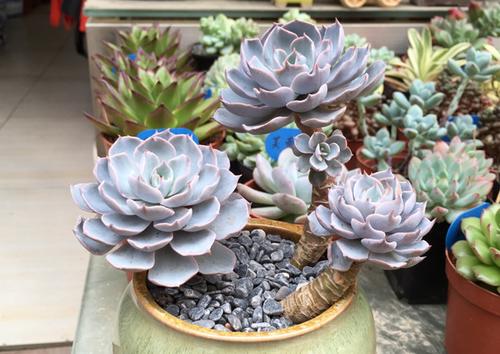Echeveria Peacockii Desmetiana profile
Written by Maggie
Mar 12 2021

Echeveria Peacockii Desmetiana is native to Mexico. Echeveria peacockii Desmetiana is suitable for growing in sunny places, prefers warm, dry and sunny environments, tolerates drought, does not tolerate cold, and tolerates semi-shade.
Echeveria Peacockii Desmetiana can be potted for viewing, or can be combined with carnivorous plants with similar ecological habits to make a combination of potted plants, flower basket, etc., or it can be made into flower artworks, which can be placed in the living room, desk, table and table, several shelves, window, balcony and other environments with good ventilation and sufficient lighting. The effect is better when matched with tea sets. It can also be used to arrange rock gardens, sand gardens and various celebration sites.
Echeveria Peacockii Desmetiana picture

Echeveria Peacockii info
| Botanical Name | Echeveria peacockii Desmetiana |
| Common Names | Echeveria Peacockii |
| Plant Type | Succulent |
| Sun | Full sun |
| Mature Size | under 6 in. (15 cm) high, 6-9 in. (15-22 cm) wide |
| Regional | California |
| Hardiness Zones | 9, 10,11 |
| Water | Drought-tolerant; suitable for xeriscaping |
Echeveria Peacockii Desmetiana morphological features
Echeveria peacockii desmetiana is a succulent perennial. The stem is stout, mature plant stem lignified. The leaf rosette is densely arranged, plant diameter is not very large, leaf blade is relatively thin, perennial green (new leaf color is light, old leaf color is dark), surface with white powder, central depression, in the shape of water drop. The tip of the leaf is relatively sharp, the edge of the leaf is smooth without fold, and the leaf has slightly white powder, while the old leaf is smooth after white powder drops. Pollen red, bell-shaped.
The stem is stout, mature plant stem lignified. The leaf rosette is densely arranged, plant diameter is not very large, leaf blade is relatively thin, perennial green (new leaf color is light, old leaf color is dark), surface with white powder, central depression, in the shape of water drop. The tip of the leaf is relatively sharp, the edge of the leaf is smooth without fold, and the leaf has slightly white powder, while the old leaf is smooth after white powder drops. The pollen red, bell-shaped.
Echeveria Peacockii Desmetiana native Habitat
Echeveria Peacockii Desmetiana is native to Mexico. echeveria peacockii desmetiana is suitable for growing in sunny places, prefers warm, dry and sunny environments, tolerates drought, does not tolerate cold, and tolerates semi-shade.

The main value of Echeveria peacockii Desmetiana
Echeveria peacockii Desmetiana is known as a "flower that never Withers" because it's rosette leaf resembles a blooming lotus. It has a unique shape, colorful leaves and easy maintenance, just like a living handicraft, which is suitable for family cultivation. echeveria peacockii Desmetiana has a unique flower shape and is a good indoor ornamental. The old Echeveria peacockii Desmetiana is a classic stone lotus in blue and white for most of the year. When the sun is sufficient, the edge of the leaf turns pink, which is of high ornamental value.
Echeveria Peacockii Desmetiana can be potted for viewing, or can be combined with carnivorous plants with similar ecological habits to make a combination of potted plants, flower basket, etc., or it can be made into flower artworks, which can be placed in the living room, desk, table and table, several shelves, window, balcony and other environments with good ventilation and sufficient lighting. The effect is better when matched with tea sets. It can also be used to decorate rock gardens, sand gardens and various celebration sites, fashion and fresh, full of fun.

How to grow and care for Echeveria Peacockii
Light
Echeveria Peacockii prefers a ventilated, dry, sunny environment. It requires proper shading in summer. It is drought tolerant, not cold tolerant and slightly semi-shade tolerant. In summer, when the plant has a short dormant period during high temperatures, the plant grows slowly or stops completely, and should be protected from direct sunlight. Spring, autumn and early summer are the main growth periods of the plants, which can be given sufficient light.Soil
Those of you who have raised a variety of succulents know that succulents prefer loose soil, as does Echeveria Peacockii. As long as you add a little sand to the soil, with a little moisture, Echeveria Peacockii will grow very well.If you can't find any gravel, you can also add shells, shingles, and the like, which will loosen the soil.Temperature
As is known to all, the temperature in summer is particularly high. As long as it is sunny, it will not be lower than 33 degrees Celsius. Then we should pay attention to placing the stone lotus in a cool and ventilated place, or using sunshade cloth to block the hot sunshine, and also spray water around it to cool down.Moisture and water
Echeveria Peacockii should be watered sparingly during high temperature, not blindly during dormancy, and should be watered with sufficient water during vigorous growth so that the plant will thrive.Water management in the growing period should grasp the principle of "see dry see wet, pouring, pouring thoroughly", and control watering in winter when the temperature is lower than 5℃.Cultivation, keep the appropriate dry environment, air humidity can be slightly larger, but the basin soil should not water, otherwise easy to rot and death.Plant growth is slow when high temperature in summer, placed in a well-ventilated environment, avoid sun exposure, and should be controlled watering and fertilization.When the air is dry, water can be sprayed around the plant to keep the air moist, but the center of the leaf cluster should not be filled with water, otherwise it will rot the heart and lead to death in severe cases.
Repot
Repot every spring. The basin soil chooses loose and breathable soil, can be mixed with peat and coarse sand, add a small amount of bone meal.Ventilation
Ensure ventilation, indoor maintenance to frequently open the window ventilation, can effectively prevent the breeding of pests and diseases. The temperature difference between day and night can be increased appropriately, and it can be preserved outdoors in spring and autumn to promote the bright color growth of the leaves of Echeveria Peacockii.Prevention of pests and diseases
To prevent the attack of Echeveria Peacockii, we can increase the frequency of ventilation to ensure the temperature and moisture of the soil. If pests and diseases occur, they should be treated immediately, and the soil should be disinfected or directly replaced with clean soil.Echeveria Peacockii propagation
Cutting propagation
Cut mature leaves at the end of spring, placed in the shade for 1~2 days, inserted in the soil after drying, or placed in the sand bed, inserted after 20 days can take root.
Hydroponics
Echeveria Peacockii is a rare hydroponics succulent. Cut a section of the top stem of the blue stone lotus, insert it into the soil, and turn it into hydroponic culture after the white root system grows.In autumn, a small amount of nutrient solution can be added in water, and water can be used in summer and winter.
Latest Updated
- Benefits of Bugleweed - 7 Science-backed Health Benefits
- Bugleweed Dangers & Side Effects - Is It Poisonous?
- How to Plant Evergreen Trees - What You Should Know
- When to Plant Evergreens - Grow Guide for Evergreen Trees
- 12 Wonderful Evergreen Shrubs for Your Garden
- 12 Popular Evergreen Plants with Pictures for Beginners
- When And How To Prune A Lilac Bush Like a Pro
- How to Grow & Care for Lilac Vine (Hardenbergia Violacea)
- Japanese Lilac Tree (Syringa Reticulata) Care & Propagation Guide
- Shumard Oak Pros and Cons - What to Know
Popular Articles
- Winter maintenance of Antirrhinum Majus
- How to Grow Terminalia Mantaly Tree
- How to Grow and Care for Crossostephium Chinense
- How to grow Antirrhinum Majus in spring
- Peristeria Elata (Dove Orchid) Profile: Info & Care Guide
- Underwatered Snake Plant (Sansevieria Trifasciata) - Signs And How To Fix
- How to Care for Brazilian Jasmine Plant (Mandevilla Sanderi)
- How to Grow & Care for Graptopetalum Purple Delight in Summer
- Rosa Chinensis (China Rose): Plant Growing & Care Tips
- How to Care for Baby Sun Rose (Aptenia Cordifolia)